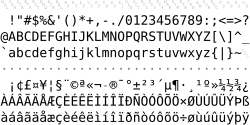
Back Latin-1 Catalan ISO 8859-1 Czech ISO 8859-1 Danish ISO 8859-1 German ISO 8859-1 Esperanto ISO/IEC 8859-1 Spanish ایزو/آیئیسی ۸۸۵۹–۱ Persian ISO 8859-1 Finnish ISO/CEI 8859-1 French ISO 8859-1 FRR
 ISO/IEC 8859-1 code page layout | |
| MIME / IANA | ISO-8859-1 |
|---|---|
| Alias(es) | iso-ir-100, csISOLatin1, latin1, l1, IBM819, CP819 |
| Language(s) | English, various others |
| Standard | ISO/IEC 8859 |
| Classification | Extended ASCII, ISO/IEC 8859 |
| Extends | US-ASCII |
| Based on | DEC MCS |
| Succeeded by | |
| Other related encoding(s) | |
ISO/IEC 8859-1:1998, Information technology — 8-bit single-byte coded graphic character sets — Part 1: Latin alphabet No. 1, is part of the ISO/IEC 8859 series of ASCII-based standard character encodings, first edition published in 1987. ISO/IEC 8859-1 encodes what it refers to as "Latin alphabet no. 1", consisting of 191 characters from the Latin script. This character-encoding scheme is used throughout the Americas, Western Europe, Oceania, and much of Africa. It is the basis for some popular 8-bit character sets and the first two blocks of characters in Unicode.
ISO-8859-1 was (according to the standard, at least) the default encoding of documents delivered via HTTP with a MIME type beginning with text/. As of July 2024[update], 1.2% of all web sites use ISO/IEC 8859-1.[1][2] It is the most declared single-byte character encoding, but as Web browsers and the HTML5 standard[3] interpret them as the superset Windows-1252, these documents may include characters from that set.
Depending on the country or language, use (on websites at least) can be much higher than the global average, e.g. (including Windows-1252), for Brazil according to website use, use is at 3.4%,[4] and in Germany at 2.7%.[5][6]
ISO-8859-1 was the default encoding of the values of certain descriptive HTTP headers, and defined the repertoire of characters allowed in HTML 3.2 documents, and is specified by many other standards. It's rarely assumed to be the encoding of text in operating systems (while it was very common in the past), though if an 8-bit encoding is used then its superset encoding Windows-1252 is most likely to be used, on Microsoft Windows if there is no byte order mark (BOM);[7] this is only gradually being changed to UTF-8.
ISO-8859-1 is the IANA preferred name for this standard when supplemented with the C0 and C1 control codes from ISO/IEC 6429. The following other aliases are registered: iso-ir-100, csISOLatin1, latin1, l1, IBM819. Code page 28591 a.k.a. Windows-28591 is used for it in Windows.[8] IBM calls it code page 819 or CP819 (CCSID 819).[9][10][11][12] Oracle calls it WE8ISO8859P1.[13]
- ^ "Historical trends in the usage statistics of character encodings for Web sites, July 2024". W3Techs. Archived from the original on 4 Apr 2024. Retrieved 2024-07-19.
- ^ Cowan, John; Soltano, Sam (August 2014). "Source of character encoding statistics?". W3Techs. Archived from the original on 4 Apr 2024.
- ^ "Encoding". WHATWG. 27 January 2015. sec. 5.2 Names and labels. Archived from the original on 4 February 2015. Retrieved 4 February 2015.
- ^ "Distribution of Character Encodings among websites that use Brazil". W3Techs. Archived from the original on 4 Apr 2024. Retrieved 2024-07-19.
- ^ "Distribution of Character Encodings among websites that use .de". W3Techs. Archived from the original on 4 Apr 2024. Retrieved 2024-07-19.
- ^ "Distribution of Character Encodings among websites that use German". W3Techs. Archived from the original on 4 Apr 2024. Retrieved 2023-01-16.
- ^ "c++ - What is the native narrow string encoding on Windows?". Stack Overflow. Jan 2011. Retrieved 2023-02-16.
- ^ "Code Page Identifiers". Microsoft Corporation. Retrieved 2010-12-19.
- ^ "Code page 819 information document". Archived from the original on 2017-01-16.
- ^ "CCSID 819 information document". Archived from the original on 2016-03-27.
- ^ Code Page CPGID 00819 (pdf) (PDF), IBM
- ^ Code Page CPGID 00819 (txt), IBM
- ^ Baird, Cathy; Chiba, Dan; Chu, Winson; Fan, Jessica; Ho, Claire; Law, Simon; Lee, Geoff; Linsley, Peter; Matsuda, Keni; Oscroft, Tamzin; Takeda, Shige; Tanaka, Linus; Tozawa, Makoto; Trute, Barry; Tsujimoto, Mayumi; Wu, Ying; Yau, Michael; Yu, Tim; Wang, Chao; Wong, Simon; Zhang, Weiran; Zheng, Lei; Zhu, Yan; Moore, Valarie (2002) [1996]. "Appendix A: Locale Data". Oracle9i Database Globalization Support Guide (PDF) (Release 2 (9.2) ed.). Oracle Corporation. Oracle A96529-01. Archived (PDF) from the original on 2017-02-14. Retrieved 2017-02-14.
© MMXXIII Rich X Search. We shall prevail. All rights reserved. Rich X Search